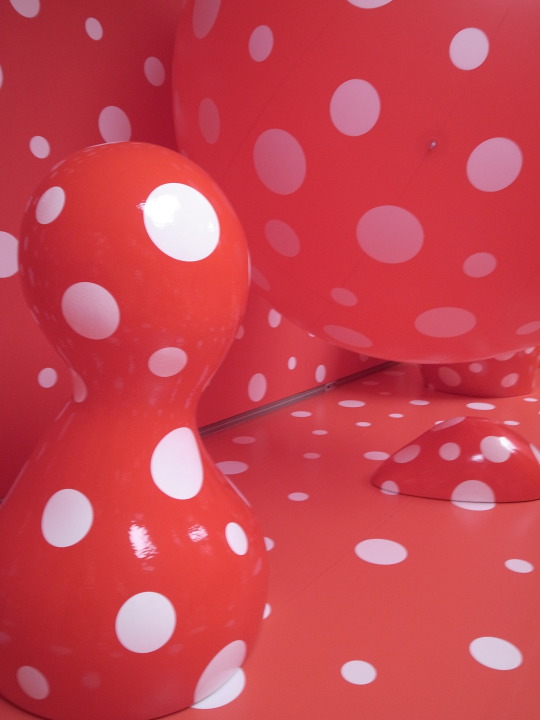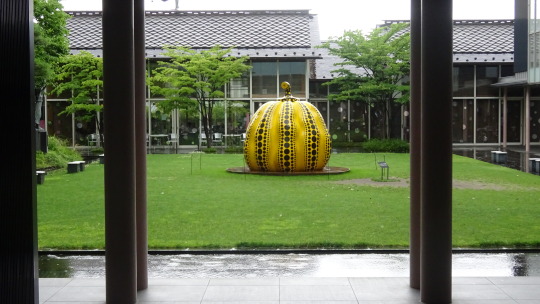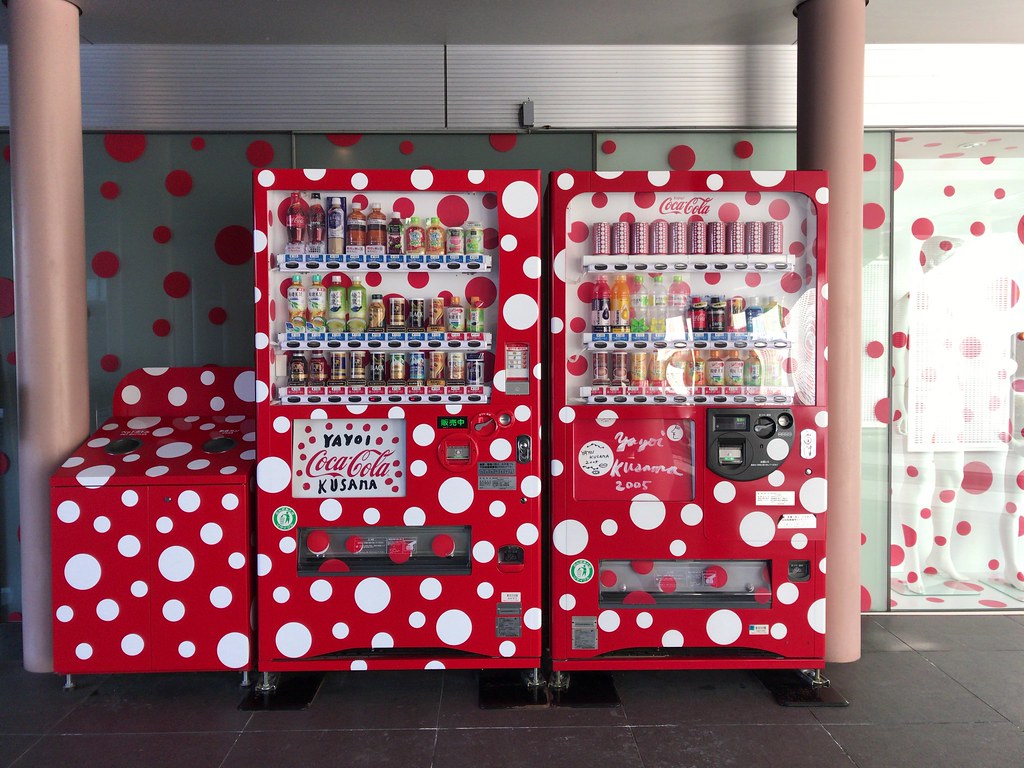#matsumoto city museum of art
Text
Milestone Monday
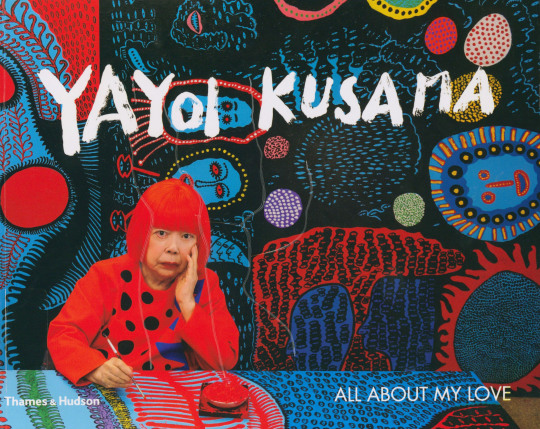

Untitled, 1939
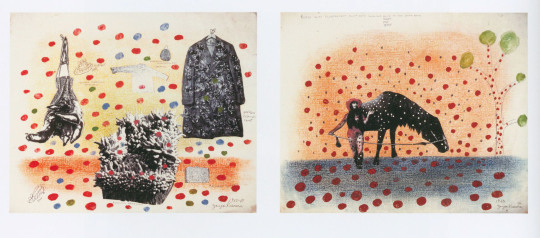
Self-Obliteration No. 1 and No. 2, 1962-67

A Pumpkin, 1999

Women of Shangri-La (Infinity Nets), 2002

Women Wishing for Peace, 2004
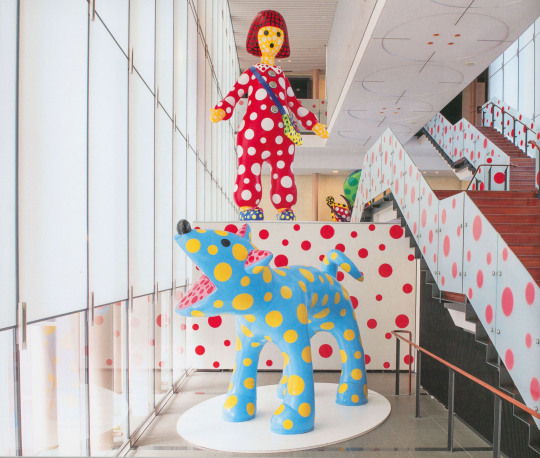
Yayoi-chan & Toko-ton, 2013

I'm Here, but Nothing, 2000/2018

My Heart with Many Worries, 2013

Tomb of Downfall, and my Spiritual Poverty Dominates my Entire Body, 2017
January 22nd is National Polka Dot Day and to celebrate we’re sharing artwork from the Queen of Polka Dots, Yayoi Kusama (b. 1929)! Kusama’s first recorded use of polka dots dates back to around age ten when she covered a drawn portrait of her mother in a field of frantic dots. More than a stylistic choice, Kusama has since shared the use of polka dots reflects the “infinity nets” present in the visual hallucinations she often experiences in relation to her mental illness. Incorporating them into her art became a way for Kusama to share and coexist with the fears prevalent in her life.
Yayoi Kusama: All About My Love, published by Thames & Hudson in 2019, is an intimate overview of Kusama’s life and career documenting the artist’s retrospective exhibition of the same name that was on view at the Matsumoto City Museum of Art in 2018. One of the many exhibition catalogs held within Special Collections, Yayoi Kusama: All About My Love offers nearly 200 color reproductions of Kusama’s work accompanied by numerous photographs of the artist, archival paraphernalia, poetry, interviews and her exhibitions throughout her long career.
Read other Milestone Monday posts here!
– Jenna, Special Collections Graduate Intern
#national polka dot day#yayoi kusama#all about my love#thames & hudson#matsumoto city museum of art#milestone monday
39 notes
·
View notes
Text

I posted 249 times in 2022
229 posts created (92%)
20 posts reblogged (8%)
Blogs I reblogged the most:
@talesofedo
@thekimonogallery
@shinsengumi-archives
@imagineyourhistoricalfigure
@littlesacrifice
I tagged 244 of my posts in 2022
Only 2% of my posts had no tags
#ronindraws - 164 posts
#original art - 141 posts
#original characters - 89 posts
#shinsengumi - 48 posts
#okita soji - 39 posts
My Top Posts in 2022:
#5

This is a very famous photo, which has been featured online in many lists of "handsome samurai" and has also been used in advertising. It was taken in 1880 (Meiji period) and shows 20-year-old Oda Nobuyoshi, who was a dentist, having just finished his studies in Edo.
There's a lesser known photo of Nobuyoshi in the collection of his great-grandson, Oda Hidemasa, who carries on the family business of dentistry at Oda Dental Clinic in Kochi City, which was founded in 1925 and is still going strong with a new building next to the original one.
Nobuyoshi certainly knew how to pose for a picture. 😅
See the full post
41 notes - Posted January 22, 2022
#4
Speaking of photos, there are a disproportionately large number of known photos of Dr. Matsumoto Ryojun still in existence. Here are a few I've been able to find, with descriptions where available.

Dr. Matsumoto, sitting front left, with Dr. Johannes Pompe van Meerdervoort, seated front right, and fellow doctors in Nagasaki.
Matsumoto went to Nagasaki in summer of 1857 as a student of Western studies at the Nagasaki Naval Training Center, where, among other things, he studied medicine under Pompe, a Dutch army surgeon.
While at first a group of 12 medical students met at the home of Takashima Shuan for lectures on biology, chemistry, anatomy, and pathology, by November of that year Pompe established a separate school of Western medicine.
Although the Nagasaki Naval Training Center closed in 1860 and the Dutch staff left, Pompe remained and opened Japan's first western-style hospital, Nagasaki Yojosho, in 1861. (The location is now Nagasaki University's medical school.)
See the full post
41 notes - Posted February 5, 2022
#3

Details on the scabbard of Hijikata Toshizo's sword. (via Hijikata Toshizo Museum on Twitter)
41 notes - Posted June 4, 2022
#2
A little “Today I Learned” write-up of notes regarding textiles in the Edo period:
+ The Kansai region, which is the area surrounding the imperial capital of Kyoto and the port of Osaka, was important in both the silk textile industry (mostly around Kyoto) and, after the 16th Century, the cotton industry (mostly around Osaka).
+ Cotton was introduced to Japan from Korea in the 1400s.
+ By the beginning of the Edo period (the early 1600s), cotton had become the primary material used in commoners’ clothing in most of Japan, replacing materials made from other types of plant fibers.
That’s not to say things weren’t still commonly made from asa (hemp or ramie) or from other plant fibers such as mulberry or wisteria - they were, especially in rural areas - but the more expensive cotton quickly became the most common choice.
On a side note: in some translations, you might see the English word linen as a translation for asa, which isn’t technically correct as linen is made from flax, which was not cultivated in Edo period Japan. The first flax in Japan is grown in Hokkaido in 1871.
+ Aside from the large amounts of cotton planted for the cotton textile trade, it was often grown in small quantities sufficient just for household consumption.
+ The Edo period and its bureaucracies placed a great deal of emphasis on laws and regulations that reinforced class structure, such as Aizu’s rules specifying which color haori-himo could be worn by which class of samurai, or Tosa’s rules forbidding low-ranking samurai from wearing certain footwear.
One sumptuary law passed by the Tokugawa shogunate limited purple outer garments to nobility and high-ranking samurai. Another banned the wearing of red outer garments, which were dyed with expensive saffron dye.
However, because those restrictions didn’t apply to inner linings or undergarments, wealthy commoners and low-ranking samurai families still found creative ways to incorporate these colors into their clothing.
On a side note: This is a good article on how silly sumptuary regulations got during the Edo period. Things like roof beam length, gold leaf decoration on household goods, and clothing materials could get you arrested.
+ On the other end of the spectrum, garments dyed blue using indigo were always a safe choice for the masses, from the lower ranks of samurai to the very bottom rungs of Edo society.
Indigo was inexpensive and could be used to produce a large variety of blue shades which, combined with the right materials and patterns, decorations, or embroideries could make up garments from the cheapest everyday kimono of a farmer to the fine silks of a wealthy merchant’s wife.
But, your choice of textiles could also easily oust you as a country bumpkin in the big city. Reportedly, even Edo’s teahouse girls laughed at samurai whose haori were lined in the cheap blue fabrics. (If I find the source again, there was an insult along the line of “blue sleeves”, but I don’t want to misquote it.)
+ There are no powered looms to produce textiles until after the Meiji restoration. The first powered looms are introduced to Japan in the 1870s but do not come into widespread use until the 1910s.
+ There is no domestic wool production during the Edo period: wool fabrics had to be imported, which made them expensive and rarely used. However, there is some wool use during the Edo period, specifically in samurai’s fire costumes (火事装束, kaji shozuku), obviously for practical reasons since wool is not as flammable as cotton or silk, and in travel cloaks. Wool becomes more common with the Meiji restoration, first to make Western-style uniforms and later to produce general Western-style clothing for those who could afford it.
(How did you stay warm and dry? Padded kimono (not unlike its modern cousin, the hanten jacket) and kamiko (paper fabrics). Here’s a neat article on kamiko.
44 notes - Posted May 26, 2022
My #1 post of 2022
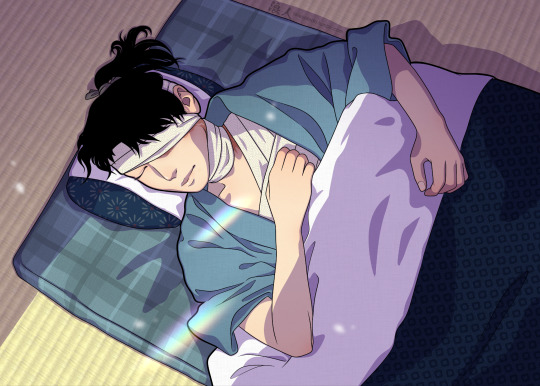
69 notes - Posted June 19, 2022
Get your Tumblr 2022 Year in Review →
#tumblr2022#year in review#my 2022 tumblr year in review#your tumblr year in review#I'm glad you guys like my history notes#excited to share more history stuff with everyone in 2023#the tags though#this is definitely not a shinsengumi blog#i swear#never mind proof to the contrary
5 notes
·
View notes
Text
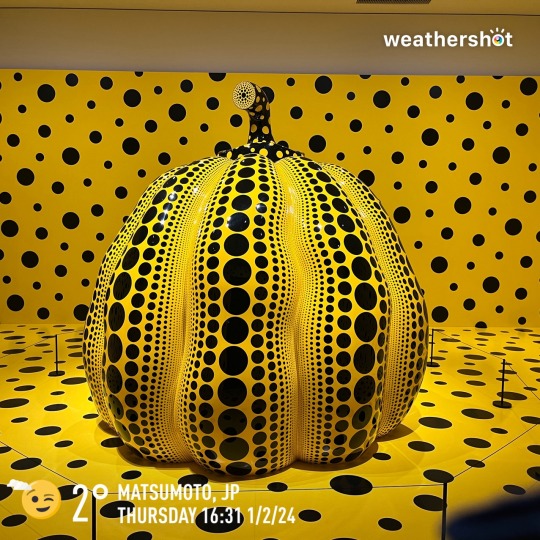
草間彌生 Yayoi Kusama
🎃 カボチャ 南瓜 Pumpkin
@ 市美術館 City Museum of Art , #MMJ , #信州 #Shinshū , #JPN •̥̑.̮•̥̑
꧁ #癸卯 #大寒 🐏 01 JAN 2024 ꧂
#昨日 #昨天 #Yesterday
https://matsumoto-artmuse.jp/
0 notes
Text
Yayoi Kusama: A Polka-Dotted Journey into the Heart of Contemporary Art
If there's one name synonymous with bold, exuberant, and immersive art, it's Yayoi Kusama. This Japanese artist, often hailed as the 'Queen of Polka Dots', has carved a unique niche in the contemporary art world with her inimitable style, infinite rooms, and larger-than-life pumpkin sculptures. Yet, beneath the kaleidoscopic colors and enchanting motifs, lies a tale of personal struggle, resilience, and transcendence.
A Fascinating Journey
Born in Matsumoto, Japan, in 1929, Kusama grew up amidst the turmoil of World War II, a fact that would later significantly influence her art. As a child, she began experiencing vivid hallucinations — a world filled with dots, nets, and flowers that would devour her. Kusama found solace in art, using her unique visions as a source of inspiration and a therapeutic outlet.
In the 1950s, Kusama moved to New York City, quickly establishing herself at the forefront of the avant-garde art scene. She rubbed shoulders with stalwarts like Andy Warhol and George Segal and played a crucial role in pioneering art movements such as pop art, minimalism, and feminist art.
Signature Style: Polka Dots and Infinity
Kusama's work spans various mediums — painting, sculpture, installation art, performance art, and literature. However, her signature style revolves around two motifs: polka dots and infinity.
The polka dot has become Kusama's most recognizable element, inspired by her hallucinatory experiences. Her fascination with infinity and the concept of obliteration is best embodied in her 'Infinity Mirror Rooms'. These installations, often filled with mirrored walls and LED lights, create a sense of boundless space, echoing her pursuit of the eternal and the infinite.
Beyond the Dots: Mental Health and Art
Kusama's artworks are not merely aesthetic experiences. They are a reflection of her ongoing battle with mental health issues, primarily Obsessive-Compulsive Disorder (OCD) and hallucinations. Her repetitive patterns and themes of obliteration are considered symbolic of her psychological struggles. Kusama's willingness to openly discuss her mental health has added depth to her work and has made her an important figure in the conversation about mental health in art.
Kusama Today
Yayoi Kusama, now in her nineties, continues to create art from her studio in Tokyo, adjacent to the psychiatric hospital where she voluntarily resides. Her work continues to inspire and resonate with people worldwide. From retrospectives at prestigious institutions like the Museum of Modern Art in New York to the Yayoi Kusama Museum in Tokyo, her work continues to captivate the imagination of audiences, transcending geographical boundaries.
Kusama's life and art serve as a reminder that beauty and inspiration can emerge from the darkest corners of human experience. Her journey teaches us about resilience, the power of self-expression, and the limitless potential of the human imagination.In conclusion, Yayoi Kusama's body of work encapsulates a profound exploration of personal and universal experiences. Through her repeated patterns, mesmerizing installations, and unabashed use of vibrant colors, Kusama invites us all to step into her world, a place where art and the human psyche merge, creating a surreal universe that is deeply personal yet universally relatable.
0 notes
Text
artest reseach
Yayoi Kusama

I wanted to show how one little thing has an impact on us and came across this article.
i loved yayois piece in this article and wanted to learn more about her
yayoi kusama (草間 彌生, kusama yayoi, born 22 March 1929) is a Japanese contemporary artist who works primarily in sculpture and installation and is also active in painting, performance, video art, fashion, poetry, fiction, and other arts. Her work is based on conceptual art and shows some attributes of feminism, minimalism, surrealism, Art Brut, pop art, and abstract expressionism, and is infused with autobiographical, psychological, and sexual content. She has been acknowledged as one of the most important living artists to come out of Japan.

kusama was raised in matsumoto, and trained at the kyoto city university of arts in a traditional japanese painting style called nihonga. she was inspired by american abstract impressionism. she moved to new york city in 1958 and was a part of the new york avant-garde scene throughout the 1960s, especially in the pop-art movement. embracing the rise of the hippie counterculture of the late 1960s, she came to public attention when she organized a series of happenings in which naked participants were painted with brightly coloured polka dots. since the 1970s, kusama has continued to create art, most notably installations in various museums around the world.
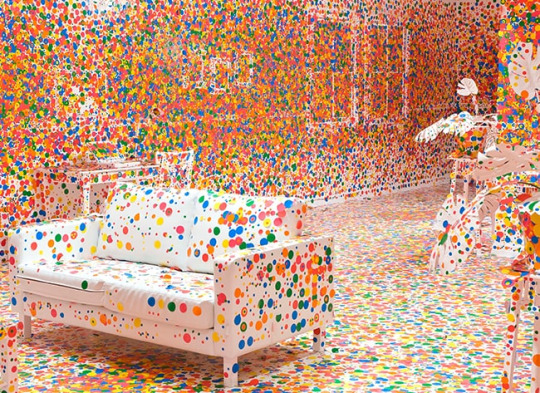
Kusama's art is fundamentally about obsession and the need, born of anxiety, to repeat certain acts in an attempt to free herself from that obsession. kusama has been open about her mental health. she says that art has become her way to express her mental problems. "I fight pain, anxiety, and fear every day, and the only method I have found that relieved my illness is to keep creating art," she told an interviewer in 2012. "I followed the thread of art and somehow discovered a path that would allow me to live."
1 note
·
View note
Photo

Matsumoto City Art Museum
4 notes
·
View notes
Text
ĐIỀU SẼ LÀM KHI ĐẾN NHẬT NGÀY THẾ GIỚI BÌNH THƯỜNG
Cơ đã đi Nhật 6 lần rồi và có vô số trải nghiệm từ ẩm thực, văn hoá đến thiên nhiên, khám phá. Cơ lập nên danh sách này để chúng ta lưu lại hẹn ngày thế giới bình thường sẽ quay lại đây tận hưởng nước Nhật nhé!
1. Ngắm hoa anh đào nở rộ khắp Nhật Bản vào dịp đầu tháng 4
=> YASSSSSSSSSSSSS, ôi trời ơi
2. Một lần thử lên tháp Tokyo ngắm nhìn toàn cảnh thành phố
=> lởn vởn quanh cái Tokyo/sky tower ko biết bao lần và ko biết bao h mò lên
3. Nếu không thích thì lên một cafe cao tầng ở khu Ginza cũng ngắm được thành phố tuyệt đẹp
=> Ginza During Sunset - DONE
4. Ngắm dòng người qua lại ở Shibuya Crossing => DONE
5. Một lần đến “Hẻm Nước Tiểu” ở quận Shinjuku, Tokyo để quay lại Tokyo của thế kỷ trước
=>Shinjuku nhiều cái hay ho lắm =)), not this
6. Cầm JR Pass, lên đại 1 chuyến tàu Shinkansen và dừng bất cứ khi nào bạn muốn => Với điều kiện có tiền nha =))))
7. Học vài câu chào hỏi thân thiện và sử dụng với người địa phương
=> Đổi Target là actually fluent at N3 level :D
8. Chèo thuyền ở công viên Chidoriga-fuchi mùa xuân về
=> Agree
9. Ngắm đồng hồ Hayao Miyazaki, co-founder của Studio Ghibli ở Tokyo
=> not a fan
10. Thử mua đồ uống, snacks, ramen từ máy bán hàng tự động
=))))))))), để khi nào thử quả ramen =))
11. Cầm dù trong suốt dạo phố một ngày mưa rơi
Must be in Nagoya or Nikko cho buồn thối ruột nữa nhé
12. Ngắm lá vàng lá đỏ mùa thu Nhật Bản
13. Nhìn thấy núi Phú Sĩ (cái này hên xui thời tiết lắm luôn)
=> ĐI hụt hai lần rồi :(
14. Một lần tắm onsen hoặc nhiều lần càng tốt
15. Ngủ tại một Ryokan truyền thống
=> đây là mục tiêu hồi đầu tiên đến nhật, mà thế vẹo nào còn chưa biết mặt mũi một Ryokan ra sao
16. Thử trà đạo tại một trà viên
=> xong số 15 thì sẽ tự ra số 16 =))
17. Hoá thân ninja và học cách ném phi tiêu, thuật ẩn thân
18. Trải nghiệm làm bánh wagashi
19. Thỉnh bùa may mắn ở một ngôi đền (có bùa cầu duyên, có bùa sức khoẻ, có bùa gia đạo quá trời luôn)
=> hồi trước mới dám bốc quẻ, may mà ngon =))). cơ mà đền ở Nhật phải thực sự thành tâm không cảm giác ám ảnh kinh luôn
20. Dạo rừng trúc Arashiyama = DONE
21. Đến thăm đền Fushimi Inari Taisha - DONE
22. Thăm chùa vàng Kinkaku-ji = DONE
23. Thăm đền Thanh Thuỷ (Kiyomizu-dera)
24. Chơi cùng những chú nai ở công viên nai Nara
25. Đến thăm Osaka Castle - DONE
26. Ngắm hoa lavender vào tháng 7-8 tại Furano, Hokkaido
27. Ăn cua hoàng đế ở Hokkaido
=> nói thiệt là đi Hokkaido là cả ty tỷ thứ nữa: Cheese, melon, lavender icecream, all other types of seafood as well la
28. Đi chợ hải sản buổi sáng ở Hakodate
29. Tham gia lễ hội lồng đèn Nihommatsu
30. Đến làng cổ Shirakawago vào mùa đông
31. Tham gia lễ hội Yakosoi tại Koichi
gạch vì thích awao odori hơn
32. Trượt tuyết ở Niseko, Hokkaido
33. Hái trái cây ở Yamanashi và ăn ngay tại chỗ
=> Thực thì chỗ nào cũng đc á
34. Thăm đền Senso-ji ở Tokyo - DONE
35. Ăn bò Kobe hảo hạng ở Kobe hoặc bò Hida ở Takayama
36. Đi chơi tại Universal Studios Japan tại Osaka - DONE
37. Đến thuỷ cung Okinawa
38. Leo núi lửa Usu ở Hokkaido
39. Mua đồ đi��n tử ở Akihabara
=> don’t try until you get to a certain level of Japanese =))). Vẫn tham vọng bò ra đây mua được cái máy dưỡng da và má ảnh phim
40. Đến hồ Shikotsu và hồ Toya cực lớn tại Hokkaido
41. Thăm lâu đài Công Chúa Himeji
42. Đến bảo tàng Manga ở Kyoto
=>Sorry but not a fan
43. Trải nghiệm teamLab Borderless tại Odaiba, Tokyo
=> YASSSSSSSS, bữa đi 1 cái teamLab, còn 1 cái nữa phải đi nốt
44. Đến Aomori ăn táo
=> và mua dấm táo giảm cân =))
45. Xem trình diễn nghệ thuật truyền thống Nhật Bản tại Gion, Kyoto
46. Tham quan và ăn sập chợ Nishiki, Kyoto
47. Dạo dọc bờ sông Kamogawa lãng mạn cùng người yêu
=> not really
48. Uống bia Sapporo ngay tại thành phố Sapporo
49. Thăm vườn thú ở Asahikawa, Hokkaido nơi có gấu bắc cực, chim cánh cụt
=> not a fan vì sẽ bò đi nơi orginal của những bạn này
50. Dạo thuyền trên hồ Ashi
51. Shopping tại Harajuku
=> đến đây mua lush xong rồi về
52. Lạc lối trong hệ thống tàu ở Tokyo
=> lạc vài lần ở Shinjuku rồi =))), never want to experience that AGAIN
53. Lên thung lũng Địa Ngục Owakudani tại Hakone vào mùa thu
54. Leo núi Phú Sĩ ngắm mặt trời mọc
55. Trải nghiệm rùng rợn đi vào “khu rừng tự sát” dưới chân núi Phú Sĩ
56. Lặn biển tại Okinawa ngắm san hô
57. Ngắm pháo hoa mùa hè ở Kobe/Yokohama
=> Thiệt tình cái firework hanabi ở đâu xem cũng đẹp á, mình sẽ đổi thành follow schedule bắn pháo hoa trên cả nước rồi đi theo. Giống kiểu xem lịch nở hoa anh đào ấy =))
58. Ăn sập Osaka – nhà bếp của Nhật Bản - DONE
59. Thử kem soft serve ở bất cứ đâu bạn đến, vì mỗi nơi lại có 1 vị đặc trưng riêng (vị than, vị wasabi, vị hạt dẻ, vị bạch tuộc, rất nhiều)
60. Tắm suối nước nóng cùng khỉ ở Nagano
61. Thăm đảo mèo Aoshima
=> not a fan
62. Đến Zao chơi với làng cáo => nốt a fan
63. Ăn ramen tại tất cả các thành phố bạn đến, chắc ngon nhất vẫn là vùng Hokkaido & Fukushima hehe.
64. Đến làng cổ Oshino Hakkai
65. Dạo quanh công viên Hitachi Seaside tại tỉnh Irabaki vào mùa thu đỏ rực
66. Hoặc tháng 6 với hoa baby blue eye xanh thơ mộng
67. Đạp xe đạo quanh Kyoto cổ kính
=> huhu, phải ở Kyoto vào mùa thu hoặc mùa đông chứ quả hè như đợt rồi nóng ko dám làm gì
68. Chạy xe Mario Kart giữa thành phố Tokyo -em vẫn muốn bình yên =))
69. Thưởng thức bữa ăn tại nhà hàng robot tại Tokyo
=> cả sushi băng chuyền nữa =))
70. Đi LOVE Hotel hehe, nhớ mang người yêu đi cùng =))
71. Thăm Pokemon Mega Center tại Osaka hoặc Toky
=> not a ffan though
72. Thăm bảo tàng Ghibli
=> định thử mấy lần mà lười lắm, khi nào có con thì a mút
73. Tham quan bảo tàng nghệ thuật MORI Art Museum
=> Not a fan
74. Thưởng thức 1 trận đấu sumo
=> YASSSSSSSSSSSSS
75. Đến một hội chợ địa phương và ăn sập mọi món bán ở đây
76. Mặc yukata/kimono dạo quanh phố cổ Kyoto => YES YES YES
77. Vào ngồi xuyên đêm tại một quán cafe manga
=> thực ra nếu xuyên đêm thì thử khách sạn con nhộng hay ho hơn
78. Mặc trang phục samurai dạo quanh thành Kasumigajo
=>(e là nữ ạ=))
79. Nhậu kiểu Nhật: uống sake, ăn oden và cơm nắm vào một ngày trời gió lạnh
=> all time wishes
80. Vào cửa hàng tiện lợi và ăn các món tại đó, rất ngon lành và tiết kiệm
=> well life of a business trip
81. Chụp ảnh với những nắp cống tuyệt đẹp trên đường phố
=> not a fan
82. Đến quán cafe trong phim Your Name ở quận Shinjuku
=> mục tiêu là mỗi lần đến Shinjuku sẽ khám phá được 1 góc, và không lạc
83. Ở dorm khi đến Nhật
=> Nope, già rồi
84. Chơi cả ngày ở Tokyo Disneyland & Disney Sea
85. Ăn món soba đặc biệt ở vùng Fukushima
86. Thăm bảo tàng Fujiko F. Fujio, cha đẻ của Doraemon tại Kawasaki
87. Đi Ferris wheel Don Quixote tại Dotonburi
=>NOPE, photo is enoguh
88. Ngủ tại một ngôi đền ở núi Koya-san
89. Ghé thăm hòn đảo nghệ thuật Naoshima
=> tự nhận là mình không có art lắm, thực sự rảnh thì might come back
90. Thử ghé qua một khu vườn kiểu Nhật nằm giữa lòng thành phố nhộn nhịp
=> đi cái công viên cạnh palace =))
91. Vào chơi game tại một tiệm Pachinko
92. Trải nghiệm quẩy không ngủ ở Roppongi, Tokyo
=> nghe bao lần rồi mà chưa thử, thực ra là chỉ có nhậu với đi KTV thôi =))
93. Vào một cửa hàng Kinokuya để trải nghiệm mua sách tại Nhật
=> well luyện level tiếng Nhật đủ, vào khu bán sách cũ ở Tokyo (or any other cities), buy an actual Japanese book
94. Tới Uniqlo mà mua đồ ngay chứ còn đợi gì nữa DONE
95. Đến khu Namba, Osaka để ăn uống và mua sắm - DONE
96. Ghé những quán cafe thú cưng
=> để coi xem có quán nào có Sheba và corgi ko
97. Lạc lối ở những con đường nhỏ tại các thành phố lớn
=> YES YES YES, hồi đó tính lang thang ở khu little Paris giữa Tokyo mà ko kịp
98. Ghé các cửa hàng đồng giá như Daiso để mua sắm đồ chỉ từ 100 yên
99. Thử một lần đi lộn tàu
=> ĐỪng, tốn tiền vãi nhái
100. Đi cùng người yêu đến Nhật Bản
Sưu tầm: Lý Thành Cơ Facebook
List của anh này dễ thương ghê, thực ra với kinh nghiệm vài lần đi công tác ở Nhật cho hay thì cố gắng đừng bị lạc ở Nhật vì người Nhật không nói tiếng anh đâu =)))
Để xem giờ nghĩ ra thêm cái gì cho list của mình (chỉ mong lần tới tới Nhật không phải là đi công tác :D
1. Food Court ở các trung tâm shopping lớn nếu không dám vào nhà hàng ăn và sẽ được thử rất rất rất nhiều món (takashimaya, SOSO, .......)
2. Bento ở Tokyo Station, cơm lươn ở khu Edo cổ Tokyo
3. Đến Nhật là phải vác đồ gốm sứ về
4. Uống trà nóng ở máy bán hàng tự động,uống calpis, all kind of barley, wheat, ...... tea
5. Vào Matsumoto Kiyoshi và BigCam mua sập hầ đồ skincare và công nghệ =))
6. Đến tất cả các Starbuck cổ trong thành phố, this’s a MUSTTTTTT
7. Mua blazer ở Nhật =))). nghe thì hơi nhảm nhưng sau bao lần làm với các đối tác Nhật, chúng nó nghiệm mặc blazer vì ở đây may blazer nhẹ và ấm sức sắc
8. Phải trải nghiệm một lần ăn sushi omakase nhé. Dù biết phải book lịch nhưng still a dream. Thực ra mà vào nhà hàng nào có đầu bếp diễn trước mặt thì đều nên thử cả (bữa là thử tempura rồi), cả yakitori nữa.
Must thử 1-2 nhà hàng michellin star ở Nhật. Không phải tự dưng Nhật là đất nước có nhiều nhà hàng michellin star nhất thế giới.
9. Không phải fan đồ ngọt nhưng strawberry shortcake and CHEESE CAKE in japan vô cung vô cùng thần thánh.
10. Một lần đi trượt tuyết ở Nhật, đâu cũng được, miễn là lạnh, Sau đó lên ăn các loại Nabe,
Tạm thời nghĩ ra thế đã, dù suốt than vãn cái sự Nhật nhưng mà nói thật là đam mê vẫn còn lớn lắm
7 notes
·
View notes
Photo
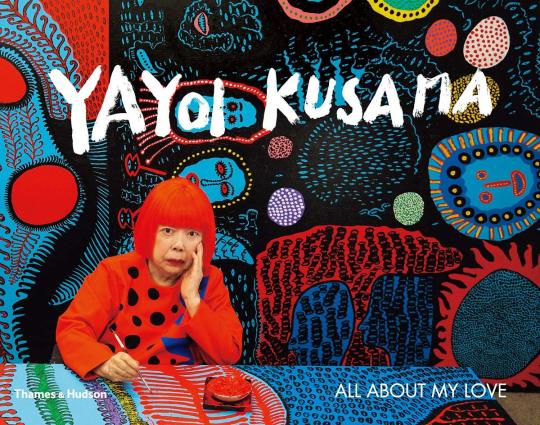
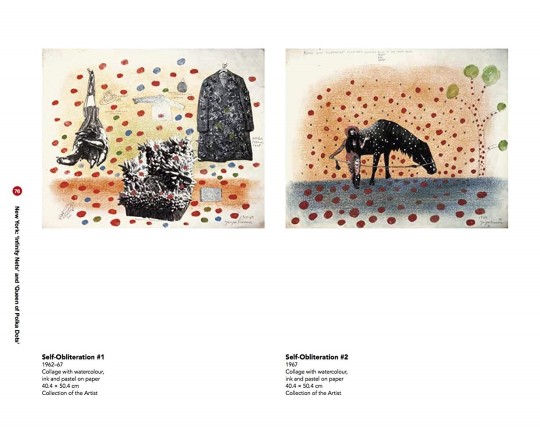

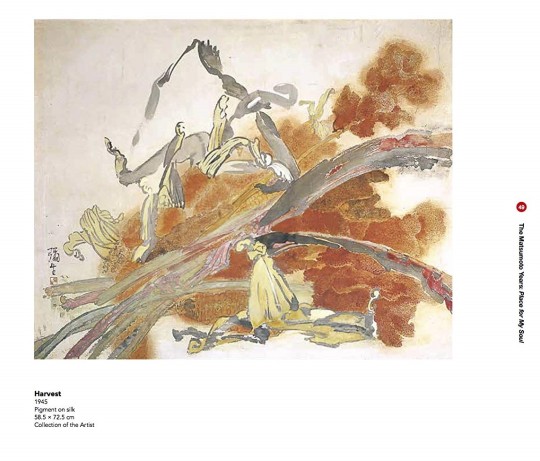
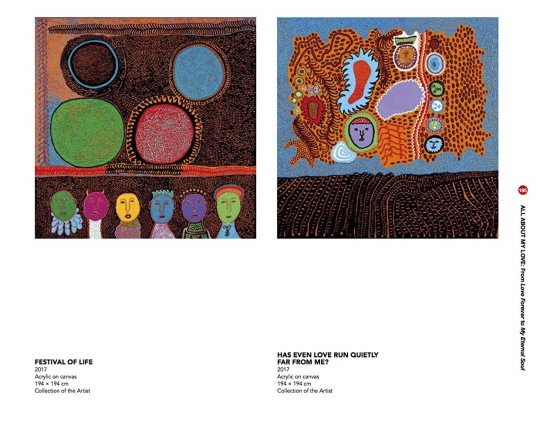
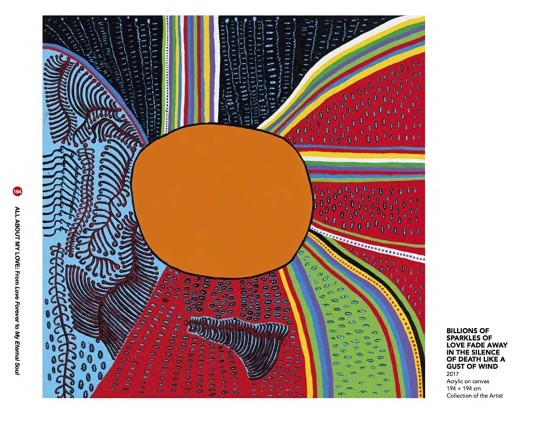

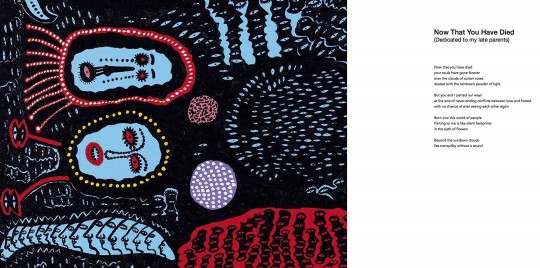
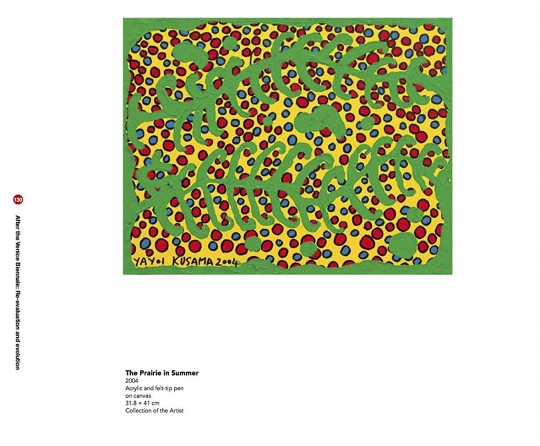

Yayoi Kusama All about my Love
Thames & Hudson, London 2019, 264 pages, ISBN 9780500295427
euro 35,00
email if you want to buy: [email protected]
Avant-garde artist Yayoi Kusama's matchless creativity and originality have been captivating the world since she moved from Matsumoto, her hometown in Nagano, Japan, to the USA in 1958. In the last ten years alone, her retrospective exhibitions in four major European and American museums, including Tate Modern, London, and the Whitney Museum of American Art, New York, have seen record attendance. Kusama has continuously innovated and re-invented her style. Well-known for her repeating dot patterns, her art encompasses an astonishing variety of media, including painting, drawing, sculpture, film, performance and immersive installation. It ranges from works on paper featuring intense semi-abstract imagery, to soft sculpture known as 'Accumulations', to her 'Infinity Net' paintings, made up of carefully repeated arcs of paint built up into large patterns. This comprehensive publication, originally published to accompany a sell-out exhibition at Matsumoto City Museum of Art, offers a comprehensive overview of Kusama's entire career, including works from her youth, when she indulged in drawing in order to escape from her hallucinations; paintings made when she was based in New York, including 'Infinity Nets' and 'Polka Dots'; works from the1980s and 1990s, when she participated in the Venice Biennale; and last but not least, the ongoing large-scale series 'My Eternal Soul'. The plates are in chronological order and followed by detailed captions.
30/04/20
orders to: [email protected]
ordini a: [email protected]
twitter:@fashionbooksmi
instagram: fashionbooksmilano, designbooksmilano tumblr: fashionbooksmilano, designbooksmilano
#Kusama#Yayoi Kusama#contemporay art exhibition catalogue#Infinity Nets#Polka Dots#retrospective#fashion inspirations#fashionbooksmilano
23 notes
·
View notes
Photo
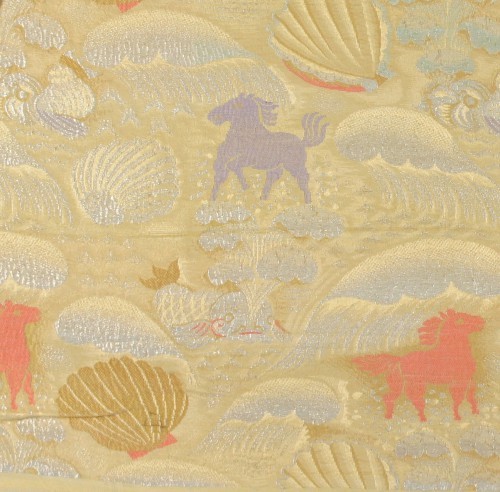
Oriental textile closeup / Matsumoto City Museum of Art
《貝殻と海の馬》1922-24年頃 金銀糸の入った錦 デュフィ・ビアンキーニ蔵
2 notes
·
View notes
Photo
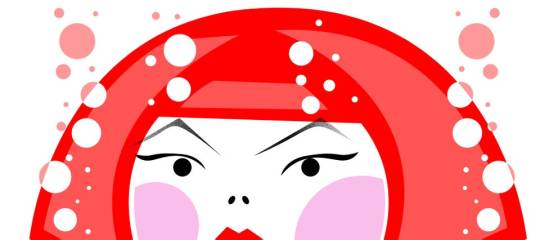
Yayoi Kusama (草間 彌生, Kusama Yayoi, born 22 March 1929) is a Japanese contemporary artist who works primarily in sculpture and installation, but is also active in painting, performance, film, fashion, poetry, fiction, and other arts. Her work is based in conceptual art and shows some attributes of feminism, minimalism, surrealism, Art Brut, pop art, and abstract expressionism, and is infused with autobiographical, psychological, and sexual content. She has been acknowledged as one of the most important living artists to come out of Japan.
Kusama was raised in Matsumoto, and trained at the Kyoto School of Arts and Crafts in a traditional Japanese painting style called nihonga. Kusama was inspired, however, by American Abstract impressionism. She moved to New York City in 1958 and was a part of the New York avant-garde scene throughout the 1960s, especially in the pop-art movement. Embracing the rise of the hippie counterculture of the late 1960s, she came to public attention when she organized a series of happenings in which naked participants were painted with brightly colored polka dots. Since the 1970s, Kusama has continued to create art, most notably installations in various museums around the world.
Kusama has been open about her mental health. By choice she lives in Seiwa Mental Hospital and says that art has become her way to express her mental disease.
Illustration by Risko.
1 note
·
View note
Photo

Built in the late 16th century, Matsumoto Castle is one of the oldest surviving castles in Japan. The main tower rises up to 5 stories,and is one of the most famous castles in Japan.
Matsumoto is filled with art, so you can explore the Japan Ukiyo-e Museum, which houses over 100,000 pieces lovingly collected by a local merchant family over the centuries, or the Matsumoto City Museum of Art which has a more contemporary focus; it features Matsumoto native Yayoi Kusama's internationally-acclaimed dotted creations, as well as the work of several other local artists.
5 notes
·
View notes
Text
Around Matsumoto - Wasabi farming, noodle making and some dotty art
13th July 2019
A long weekend in July is the optimum time to take advantage of the cool mountains of Kamikochi. This year though the rainy season was a long one. Many weekends from June throughout July and into August were wet and miserable. With the forecast looking unencouraging we were determined to try so headed to Matsumoto as the starting point for our mountain adventure.
The forecast for the mountains though was determinedly disappointing with the most concerning point being the thunder and lightning. A mountain is not the best place to be during a storm especially when the Japanese have chains and metal ladders on the more difficult climbing routes. Regretfully we needed to come up with a plan B - at least for the time being.
As the morning was a sunny start we decided to head to Daio Wasabi farm in the rural Azumino City a half an hour train ride from Matsumoto. The farm had a wide range of wasabi products available not just your ordinary processed wasabi but the real stuff. They use the ice cold water running off the Nagano mountains and irrigate it into a network of small streams where the wasabi is grown.
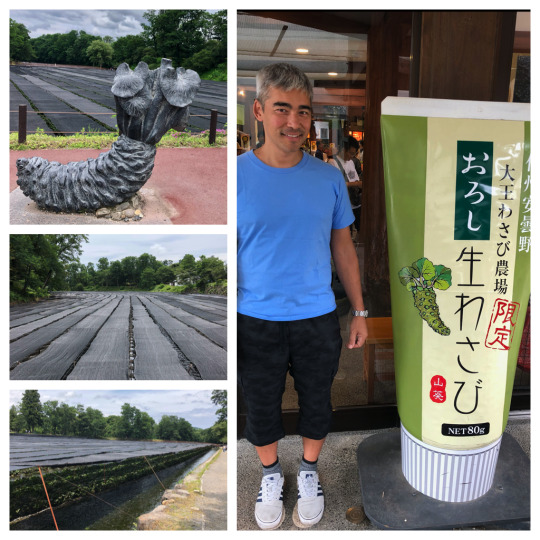
After sampling some of the wasabi treats we headed back to explore some of the historical streets of Matsumoto following a vague food and drink tour .

The next day, still thwarted by the weather, we remained in Matsumoto and tried our hand at Soba making.
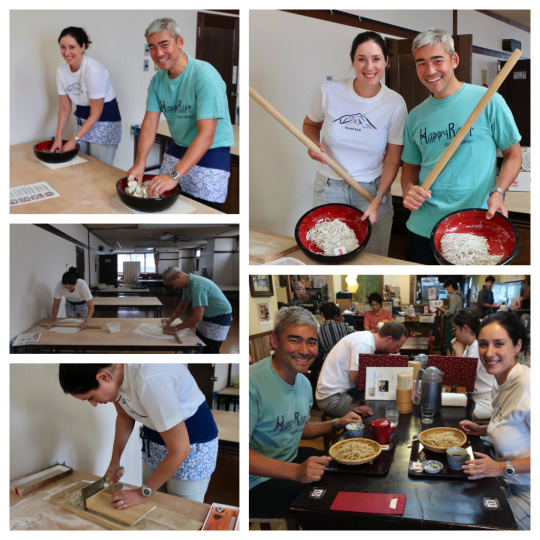

We were instructed by our very own soba master. We were shown the process and used the authentic soba making tools. I definitely got flashbacks to woodwork DT but managed to produce something soba like. They were then taken away and cooked for us. They were probably a little chunky compared to real soba noodles but tasted fine, its a bit hard to mess up when its essentially flour and water. The left over soba we had made, they deep fried and gave to us as a tasty crunchy snack.
The other sight on our rainy day list was The Matsumoto City Museum of Art. The artist Kusama Yayoi was brought up in Matsumoto so the city has an extensive collection of her work. Sculptural Flowers welcome visitors. The collection follows the artists’ development from childhood pieces through to an apartment covered in dots and the infinite reflections room. The work comes from a dark place conceptually but definitely brightens an otherwise gloomy day.

3 notes
·
View notes
Video
草間彌生 x Coca Cola by Yoshizawhat!
Via Flickr:
Yayoi Kusama x Coca Cola @ 松本市美術館
0 notes
Photo

Yayoi Kusama, ‘The Visionary Flowers’
#traveller#views#yayoi kusama#the visionary flowers#matsumoto city museum of art#matsumoto#nagano#japan
2 notes
·
View notes
